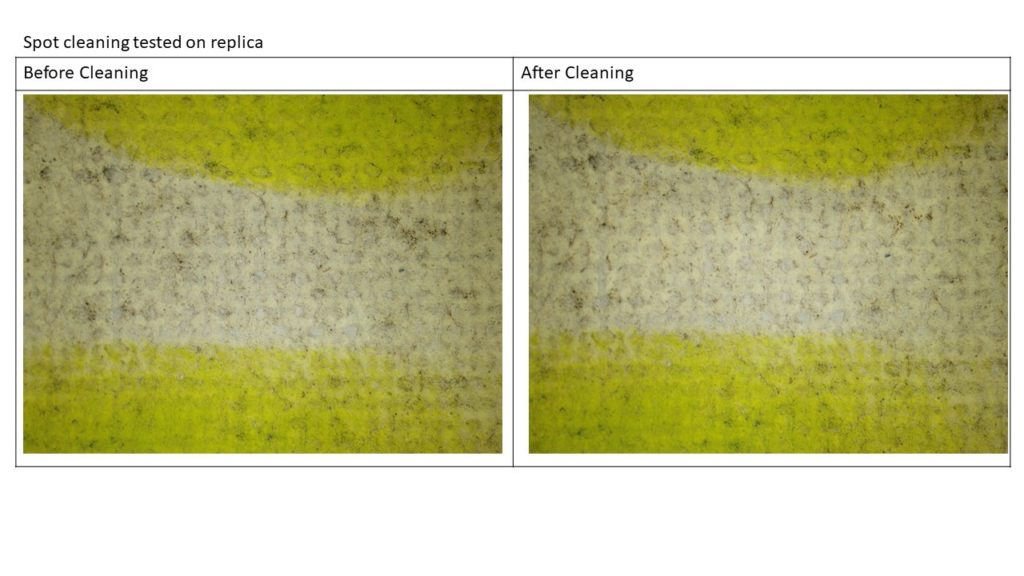
By Chuance Chen, recent graduate, MPhil Textile Conservation.
During my second year, I was fortunate enough to have opportunity to undertake the conservation of a Mackintosh stencilled panel. I have always been interested in painted textiles and this project also offered me fantastic opportunities to work collaboratively, to learn new techniques and to engage with colleagues in The Hunterian.
The stencilled panel, now in the private collection of Professor Pamela Robertson former Senior Curator at The Hunterian, has a fascinating history. It was part of the wall covering of the Cloister Room in Ingram Street Tearooms designed by Charles Rennie Mackintosh and was possibly used between 1900 to 1911 before it got concealed due to refurbishment.[1] A dissertation written by Technical Art History (TAH) MLitt student Ekaterina Vinokurova, titled ‘Materials and Techniques employed by Charles Rennie Mackintosh in Stencilled Panel Decoration of Ingram Street Tearooms’ provided valuable information of the object condition and history. Ekaterina’s technical analysis was also useful as it identified that the cotton canvas support has a proteinaceous size, the ground layer predominantly contains zinc white, and the stencilled layers are formed using pigments bound in water and gum elemi (watercolour).

Professor Robertson requested that the stencilled canvas received minimum cleaning and for it to be mounted in a way that it can be framed for display. Water stains and surface marks were found on the painted layer. The panel also had a greyish appearance due to the accumulation of dirt during its functional life. The paint surface was in stable condition, so consolidation was not deemed necessary. One of the first tasks was to investigate the removability of surface dirt through a spot cleaning test and for this I was privileged to make use of the conservation research laboratory at Kelvin Hall and to work under the supervision of Professor Christina Young, Professor of Conservation and TAH. Spot cleaning was tested out on a replica stencil created by Ekaterina for her dissertation and then a discrete corner on the object in order to give an indication of the removability of the soiling and stains and to evaluate the effectiveness of potential cleaning agents.




soil particulates were moderately been reduced after cleaning
© University of Glasgow and with kind permission of Prof. Robertson
The test result indicated that the soiling could be removed, but the process might risk paint loss and could also result in an uneven level of cleaning as the soiling was more ingrained in some areas than others. The result of the spot cleaning test was presented to the client and treatment options discussed – it was decided that any tonal differences resulting from uneven cleaning could detract from the overall appearance of the panel, that they were not detrimental to the condition of the object condition. Furthermore the soiling could be seen as part of the object’s biography and provide an interesting insight in storytelling.
The treatment was then to stabilise the tacking holes using localised patch supports and adding strip linings for it to be mounted onto a custom made padded board. The process of mounting involved tensioning out the panel through the strip linings. The panel was subjected to controlled tensioning by hand and pins onto the padded board over two weeks. During this period, the distribution of tension and flatness of the panel were monitored to ensure it was evenly supported. Once that was achieved, excess fabric from the strip linings was trimmed and then stitched to the underside of the padded board. The result was a structurally supported panel!

Lots of pinning and alignment checking! © University of Glasgow and with kind permission of Prof. Robertson 
Mounting in progress © University of Glasgow and with kind permission of Prof. Robertson
Not long after the object returned to the client, I was contacted by Mr Joseph Sharples, Mackintosh curator at The Hunterian University of Glasgow, to give a talk about my conservation treatment. I was delighted to have this opportunity to engage, and of course, share the value of textile conservation to members of the public. The event, which took place at the Mackintosh House, was well-attended and was definitely a meaningful way to conclude my project!
My sincere thanks to Professor Robertson and my tutor, Ms Karen Thompson, for entrusting me with the object. Many thanks to Professor Christina Young, Dr Caroline Rae and Joseph Sharples for their precious support!

Further reading:
Glasgow Museums. Glasgow’s Hidden Treasure: Charles
Rennie Mackintosh’s Ingram Street Tearooms. Glasgow: Glasgow Museums, 2004.
[1] Ekaterina Vinokurova,” Materials and Techniques employed by Charles Rennie Mackintosh in Stencilled Panel Decoration of Ingram Street Tearooms” (unpublished TAH MLitt dissertation, University of Glasgow 2017), 17-18.


Attn Chuance Chen,
Might you be interested in writing something for the Textile Society on this project? Email me on Newsletter@textilesociety.org.uk.
Pat Frost
Hi Sarah
I wonder if this stencil could benefit from some cleaning trials ( at the UoG or possibly at the V&A)? Using the ultrasonic cleaner?
Hope you’re keeping well
Best regards
Harry
Hi Harry,
Nice to hear from you – hope all is well. Interesting idea to try the ultrasonic cleaner but I don’t think it would be appropriate for this object – the paint was quite fragmentary and it wouldn’t respond well to moisture.
But it would be great to hear of other projects where you have been using it,
S